By Julie A. Caucino, DO
Does your child complain of not being able to catch their breath when they come off the soccer field or basketball court?
Do they wheeze after playing with the family pet?
Do they cough incessantly after being outside in the cold?
These are signs that could indicate your child is one of the millions in the United States who suffer from asthma, a chronic respiratory condition that can leave children struggling to breathe.
If you suspect your child has asthma, see your pediatrician or an allergy and asthma specialist for an evaluation, treatment, and to create an asthma action plan to prevent and manage flare-ups.
Common in Childhood
Asthma is an inflammation and narrowing of the airways, often producing excess mucus that makes breathing difficult.
Asthma is common in childhood, according to the American Academy of Pediatrics, which estimates 10% to 15% of grade school children in the United States have or have had the condition.
Although it is uncertain why some children develop asthma, studies have identified certain predictors of the disease including:
• Inhalant, food, and skin allergies such as eczema.
• Family history of allergies or asthma.
• Prenatal or postnatal exposure to cigarette smoke.
• Living in an area with high air pollution.
• Possibly obesity.
Wheezing is Not the Only Symptom
While wheezing is commonly associated with asthma, you do not have to wheeze to have asthma. Other signs and symptoms, which may occur intermittently, can include:
• A persistent cough that worsens with colds, or lasts longer than normal after cold symptoms resolve.
• Coughing or shortness of breath causing a child to awaken during sleep or early morning hours.
• Rapid breathing.
• Shortness of breath and/or chest tightness with exercise.
• Not wanting to participate in sports, dance, or other physical activities.
• Younger children may complain their chest “hurts” or feels “funny.”
• The feeling of not being able to take a deep breath.
• Tiredness.
According to the American Academy of Allergy, Asthma and Immunology, asthma flareups are most often triggered by allergens and colds. Common allergens include:
• Dust and dust mites
• Pollen
• Pet dander
• Molds
• Cockroaches and rodents
Non-allergic triggers such as cold air, secondhand smoke, temperature changes, exercise, and air pollution can also trigger asthma symptoms.
Diagnosis and Treatment
When diagnosing asthma, a detailed history is critical. Asthma in children can sometimes be difficult to diagnose, especially at younger ages. Your doctor may ask to describe the symptoms and when and where they occur.
Do you notice any patterns? For instance, do symptoms flare-up after visiting a friend’s house where there is a dog or cat? Do they occur almost every time the child has a cold? Or do they occur after running around outside?
Identifying what triggers symptoms is one of the most important steps toward an accurate diagnosis and treatment plan.
Additionally, allergy testing, or depending on the age of your child, a lung function test may be recommended to manage your child’s asthma.
Treatment of asthma involves medications, education, and environmental control. Asthma medications generally focus on long-term management to control the condition and prevent flare-ups as well as quick-relief treatment to rapidly reduce symptoms when they occur.
Controller medications, most commonly low-dose inhaled steroids, are generally used daily to stop asthma flare-ups before they occur. The asthma management guidelines for children from the National Institutes of Health recommend that children who have symptoms more than twice a week or who wake up more than twice a month because of their symptoms use controller medication.
Controller medications might also be recommended during certain times of the year or in certain situations that are known to trigger your child’s asthma symptoms, such as during spring allergy season or when your child is getting a cold.
Quick relief medications, such as albuterol, are taken for short-term relief and work quickly to open up the airways and restore normal breathing.
Asthma Action Plan
If your child is diagnosed with asthma, it is important to work with your doctor to develop a written asthma action plan to help manage the condition. In general, the plan should include:
• Treatment information, such as what medicines to take and when.
• A list of possible triggers.
• Early symptoms and how to address them.
• How to initially handle an asthma attack.
• When to call the doctor or go to the emergency room.
The American Academy of Pediatrics and The American Academy of Allergy Asthma and Immunology note that all the people who care for your child should have a copy of their asthma action plan.
In most cases, you can manage your child’s asthma at home in consultation with your doctor. However, if your child’s symptoms are severe or worsening or medication is not working, seek emergency care immediately.
While childhood asthma can be a serious medical condition, by identifying triggers, seeking treatment, and taking action, you and your child will be able to breathe easier.
To find a physician affiliated with Penn Medicine Princeton Health, call 888-742-7496, or visit www.princetonhcs.org.
Julie A. Caucino, DO, is board certified in allergy and immunology and is a member of the Medical Staff at Penn Medicine Princeton Health.

